
|
|
Für die deutsche Fassung bitte nach unten scrollen
|
|
Happy New Year – or as the Romans would say: "Annum novum faustum felicem!"
|
|
|
The good news first: Although our galleries in Vienna have to remain closed until 17 January 2021, collections are possible at any time. We are also pleased that we can offer free shipping worldwide for all objects in this newsletter (and for most on our website). The pandemic can physically separate us, but it cannot take away our joy for ancient art.
|
SAVE THE DATE. And we are not only optimistic for 2021, we also have a lot of plans: on 27 February we will start an intensive art fair year in Vienna and Salzburg with our participation at WIKAM. In our showroom in Vienna we are planning four exhibitions this year, the first one immediately after WIKAM. And we have succeeded in acquiring outstanding ancient art collections and objects, which will for sure surprise you this year. This newsletter offers a first foretaste with the Chalcidian helmet and the Samnite trefoil-plate from the world-famous Guttmann collection. Look forward to a year full of wonderful moments, a year of reunion and a year in which we are starting with particular optimism!
|
|
Our Highlight of the Month:
|

|

|
|
|
|
Greece – 5th-4th century B.C.
|
Rare, Chalcidian bronze helmet with a clearly offset, elongated calotte, steep ridge and profiled brow gable with a large face cutout. On the brow and on the neck an eyelet for attaching the crest. Pointed, fixed cheek pieces, a perforation for a chin strap in front of each large ear-hole. A flaring neck guard, the edge of the helmet is thickened all around. An ancient repair on the back of the neck. Inside an old label from the renowned Axel Guttmann collection with the inscription AG 194. Published in: H. Born, Restaurierung antiker Bronzewaffen – Sammlung Axel Guttmann, Vol. 2, Mainz 1993, example II. Mounted.
|
Provenance: Private collection Axel Guttmann with the inventory number AG 194, acquired 1988 in Freiburg, Germany. With a photograph depicting the helmet in the Guttmann collection. Thence at Hermann Historica auction on 7 October 2009, lot 176 (there sold with a plume holder not belonging). Last in the English art market. Accompanied by a French antiquities passport.
Dimensions: 25 cm high
Price: 32 000 Euro
|
|
|
|
Selected Artworks of the Month:
|

|
|
|
|
|
|
Egypt – Late Period, 26th dynasty, 664-525 B.C.
|
Extremely finely crafted green and black faience statuette of the Egyptian goddess Taweret, who is also known under the Greek name Thoëris. Taweret, the protective goddess of pregnant women, appears in the body of a pregnant hippopotamus, has human breasts and the head and mouth of a hippopotamus. The arms are human, the paws those of a lion. She has her arms in front of her stomach and is holding the Sa amulet, an ancient Egyptian hieroglyph that stands for protection. Taweret wears a black tripartite wig, the front lobes of which reach down to her pendulous breasts. The tenon on the head once held a metal sun disk. In the back a hatched back pillar, which stands for the stylized tail of the crocodile. The high quality of this statuette suggests that it was made for the temple, possibly for the Egyptian "birth house", where this goddess was linked with Isis. On an old, trapezoidal wood base.
|
Provenance: Old French private collection acquired in the 1960s. Thence in the Spanish private collection O.P., Barcelona, Spain. Accompanied by a Spanish antiquities passport.
Dimensions: 10 cm high
Price: 12 000 Euro
|
|
|
|
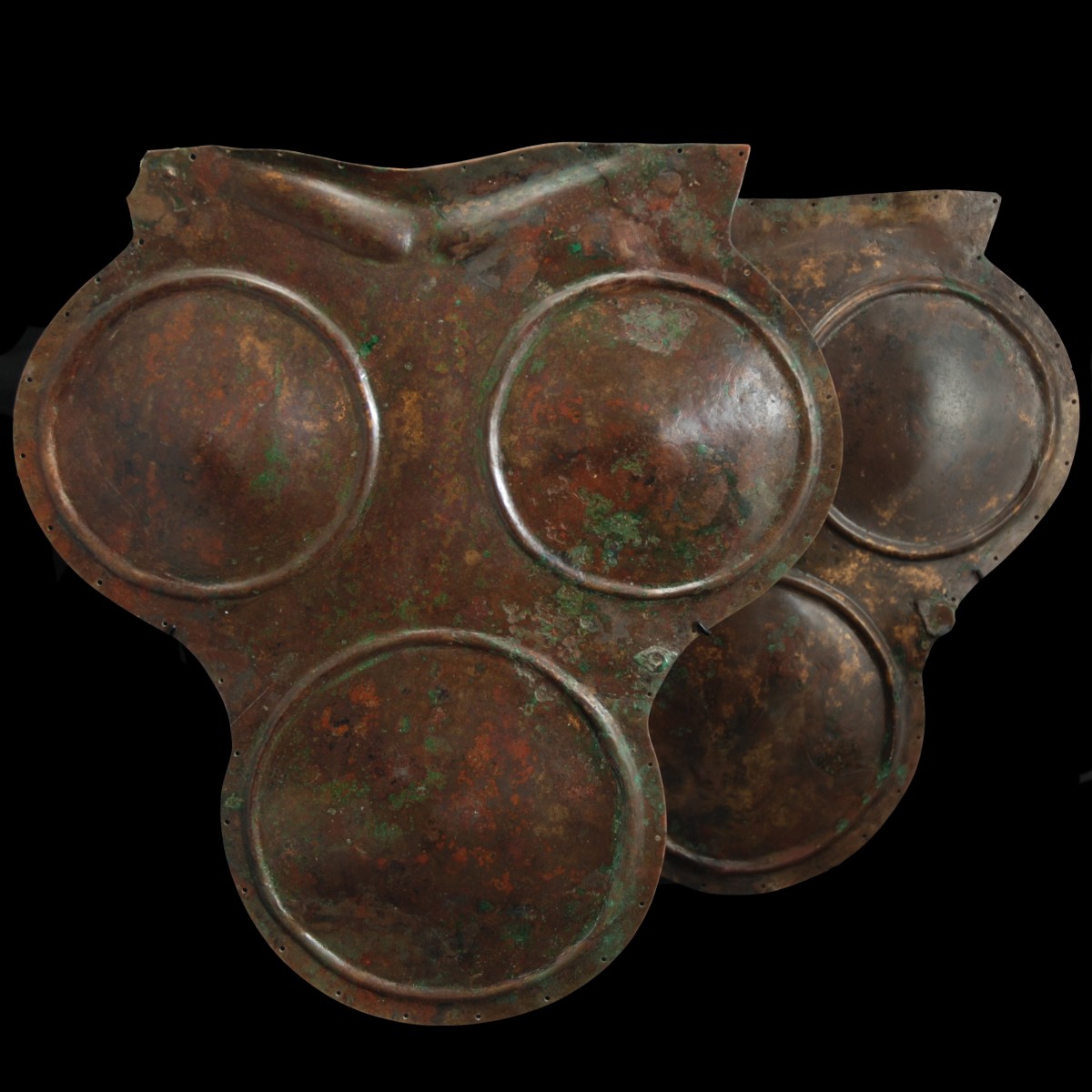
|
|
|
|
|
Almost identical breast and back plates of a so-called "trefoil-plate cuirass" consisting of three cambered discs. The upper end of the breastplate with modeled clavicles. The two upper discs are each tapered in the form of chest muscles. Lining holes drilled at regular intervals all around, a riveted tab on each side in the middle (one missing) for fastening the side and shoulder connections. On the back of each an old label from the renowned Axel Guttmann collection with the inscription AG 433. Published in: H. Born, Restaurierung antiker Bronzewaffen – Sammlung Axel Guttmann, Vol. 2 (Mainz 1993), fig. 34, 35. Mounted.
|
Provenance: Private collection Axel Guttmann with the collection number AG 433, acquired 1990 in Krefeld, Germany. Thence Hermann Historica auction on 11 April 2008, lot 348. Last in the English art market.
Dimensions: Heights: 30 cm (breast plate), 28 cm (back plate)
Price: 12 000 Euro
|
|
|
|
|
|
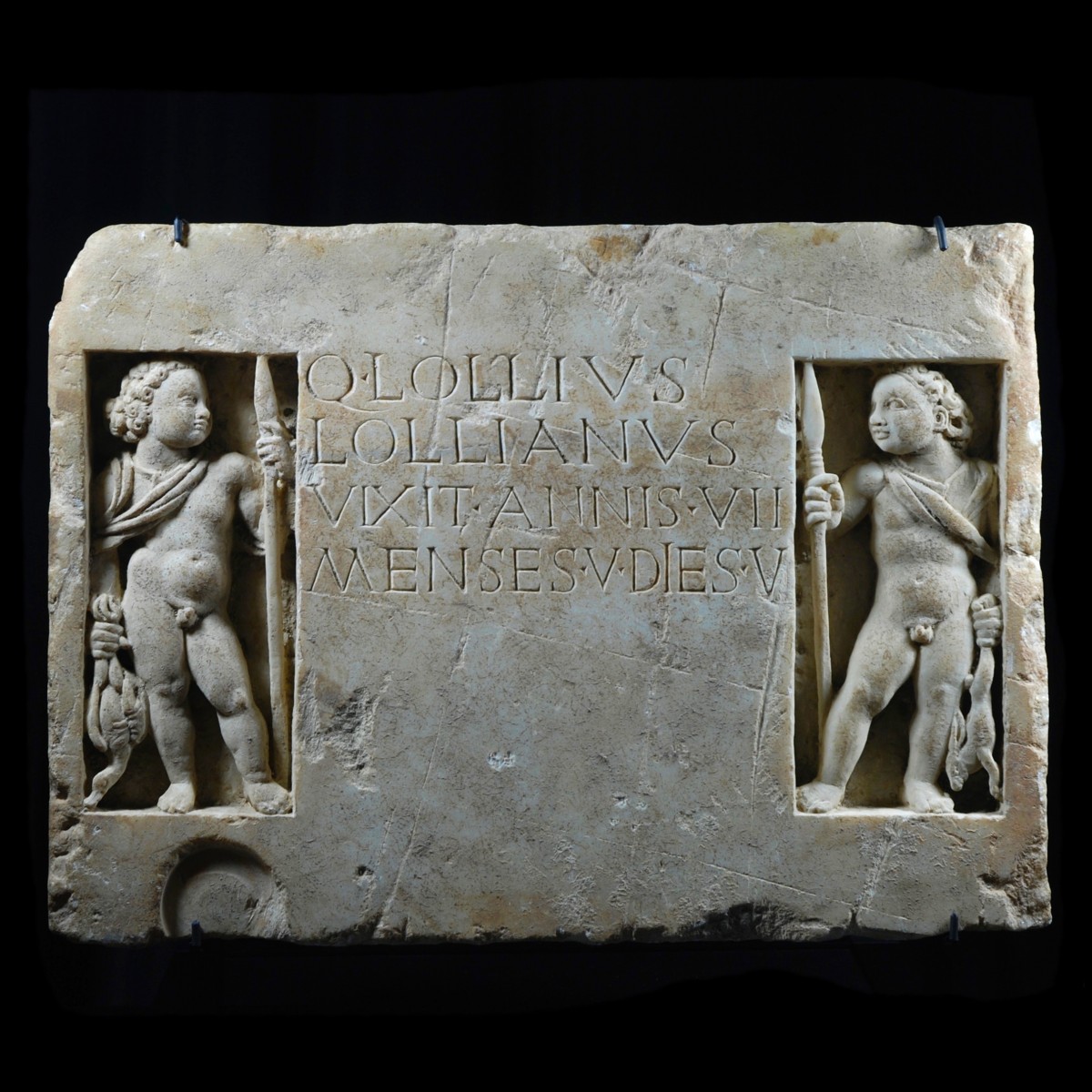
|
|
Roman Empire – Late 2nd to early 3rd century A.D.
|
Large, finely worked out marble relief of a sarcophagus with a four-line inscription and two cupids on the outside. The inscription reads: "Q. Lollius Lollianus vixit annis VII Menses V Dies V" (Translation: "Q. Lollius Lollianus lived seven years, five months and five days"). The finely crafted cupids with curly hair and capes stand in niches. The one on the left holds a duck in his right hand and leans on a spear in his left. He represents winter. His gaze is directed to the right to his counterpart autumn. The autumn cupid holds the hare in the left hand and leans on a spear in the right. The two other seasons were probably shown on the missing bottom. A touching fragment of wonderful quality. Mounted.
|
Provenance: From an old American collection, auctioned at Hindman auctions in October 2017. Thence in the English art market.
Dimensions: 42.5 cm x 60 cm
Price: 28 000 Euro
|
|
|
|
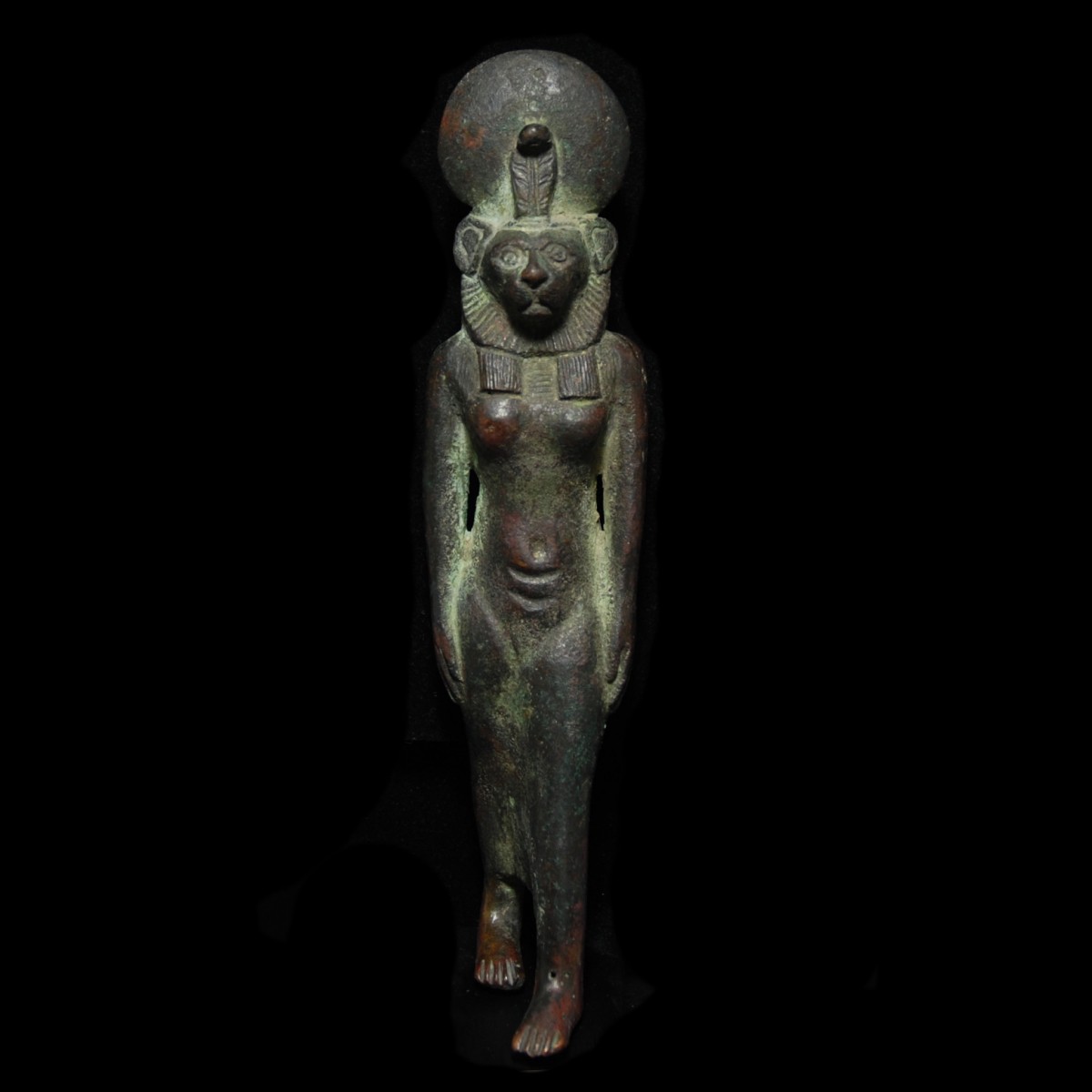
|
|
|
|
|
|
Egypt – Late period, 664-332 B.C.
|
Cast bronze statuette of the striding Sekhmet with her left foot forward. The lion-headed goddess wears a tripartite wig with finely drawn strands, the Usekh collar and a tight fitting dress which reaches to the ankles. She has both arms at the sides of her body. On her head she wears a large sun disk with uraeus. On the feet the tenons for mounting on the separately worked out base are still preserved. Sekhmet, whose name translates as “the Mighty”, was the goddess of war, but also of protection from diseases and for healing. Mounted.
|
Provenance: Private collection Dr. Yves Goalard, France, acquired in the 1970s. Last in a Belgian auction house.
Dimensions: 20.5 cm high (including tenons)
Price: 12 000 Euro
|
|
|
|
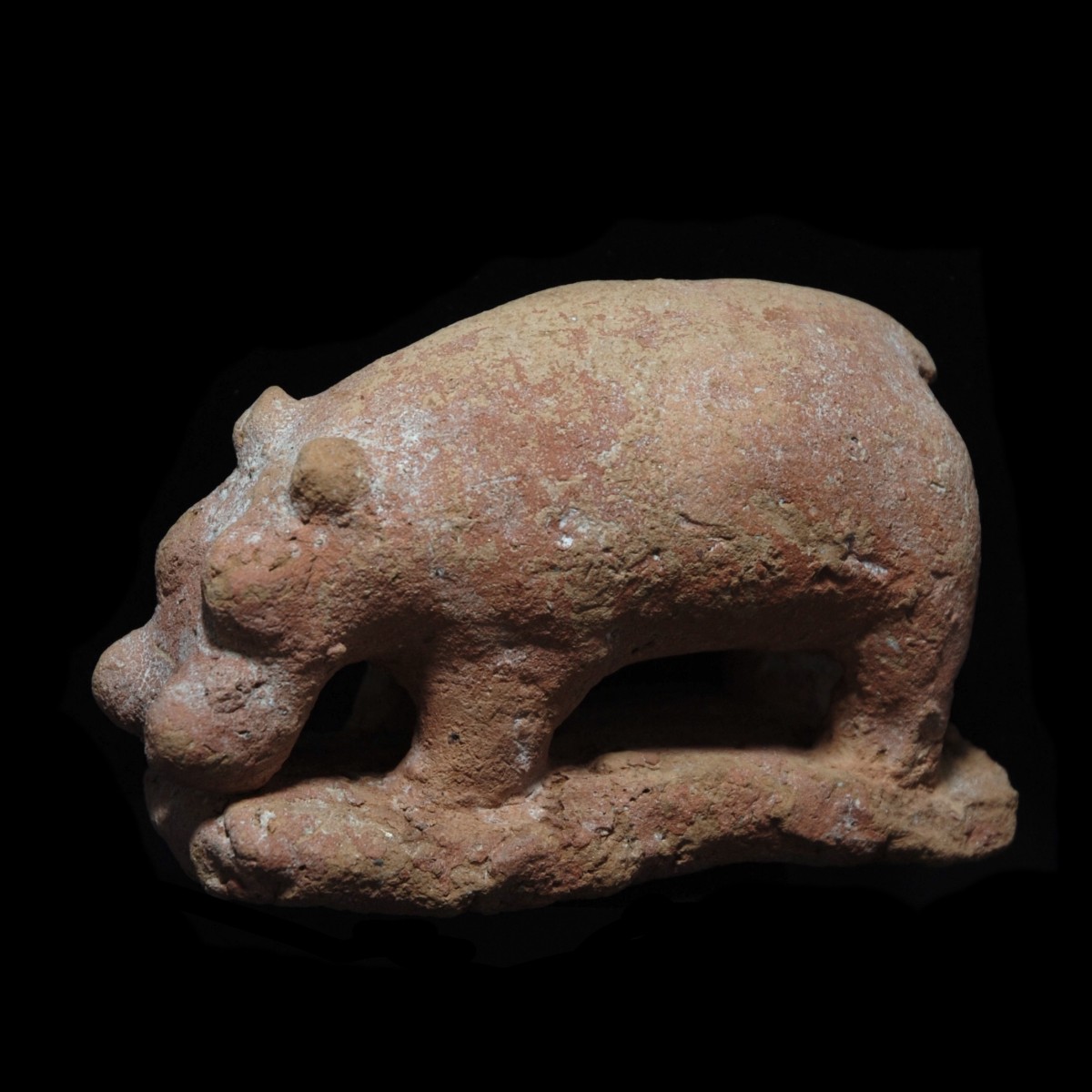
|
|
|
|
|
|
Egypt – Middle Kingdom, 2040-1648 B.C.
|
Large, hand-formed terracotta hippopotamus on its original plinth. The animal with a rounded back, short legs, stumpy tail and a massive, slightly lowered head. The ears, eyes and nostrils spherical and large. In the Middle Kingdom, hippopotamus were often given to the grave as the strong animal was a symbol of regeneration in the afterlife. In addition, the fearsome animal that the living feared should also frighten grave robbers. With remains of white painting.
|
Provenance: Collection of the art dealer Elias David (1891-1969). Last in a French collection. Accompanied by a French antiquities passport.
Dimensions: 13.5 cm long
Price: 8 000 Euro
|
|
|
|
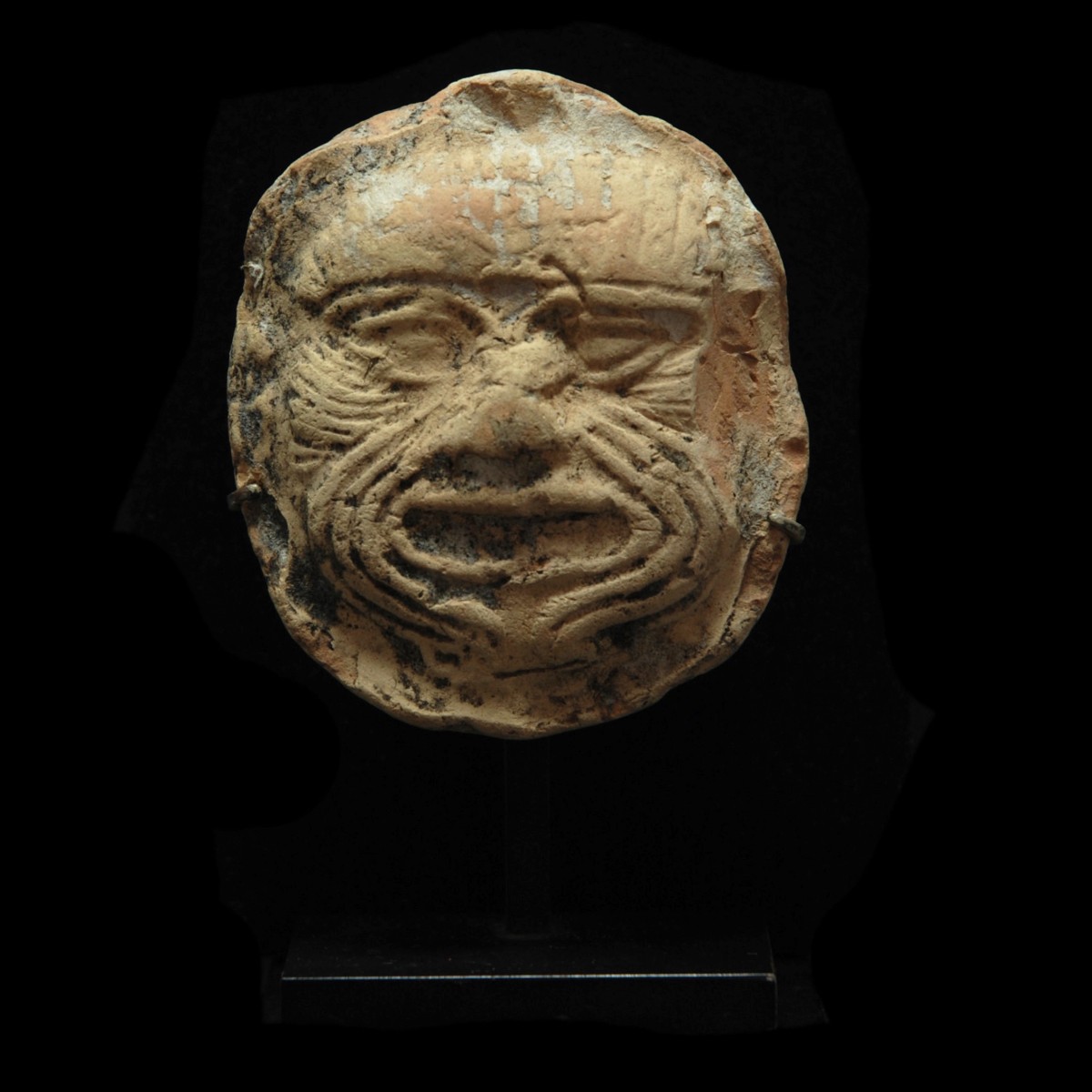
|
|
|
|
Sumer – 1st half 2nd millennium B.C.
|
Almost circular terracotta plaque of light clay depicting Humbaba’s head. The guardian of the Cedar Forest was beheaded by Gilgamesh and his loyal friend Enkidu because they wanted to cut cedars in the forest of the goddess Inanna. Humbaba had supernatural abilities as a demon, he was in possession of fears and was able to recognize his enemies from a far distance. Plaques such as the present one were used to keep evil away, but also to bring luck to the owner. Humbaba has a broad nose, alert eyes sitting between strong lids and deep wrinkles under the eyes. Parallel hair strands falling into his forehead. The mouth is open to a broad grimace, making the row of teeth visible. Typical for the depiction of Humbaba from Mesopotamia is the long moustache, framing the mouth and reaching to the chin. The moustache ends are curled in. Mounted.
|
Provenance: From the estate of Daryl P. Gruber-Kulok, New York and Connecticut. Last with Art for Eternity, New York.
Dimensions: 7 cm x 6.2 cm
Price: 3 200 Euro
|
|
|
|

|
Large alabaster fragment of a Sumerian prayer statue. Preserved is the kaunakes, the Mesopotamian tufted skirt from the 3rd millennium BC, which was worn for ritual purposes. The garments consisted of a woolen fabric that was modeled as a sheepskin, in which wool tufts were woven in layers one above the other, or loops were pulled from the weft thread during weaving, so that a pile fabric was created. The kaunakes of this prayer statue is particularly finely worked. The conical skirt is structured by six encircling rows of tufts that expand downwards. Each individual tuft is decorated with three vertical, deep notches. The upper body is broken at the base . The smoothed bottom of the skirt and the leg stumps have been preserved. See for reference the Sumerian praying statues with kaunakes in Pierre Amiet “Die Kunst des Alten Orient”, fig. 288-293, Munich 1977. Mounted.
|
Provenance: German collection Ertel 1970s. Thence with Antikenkabinett Bernd Gackstätter with the inventory number 3215. On 26 October 2000 sold to the private collection of Peter Hollander (1931-2014), Amsterdam, Netherlands. Since then in a family estate. With the original invoice and original certificate from the Antikenkabinett.
Dimensions: 14 cm high
Price: 8 000 Euro
|
|
|
|
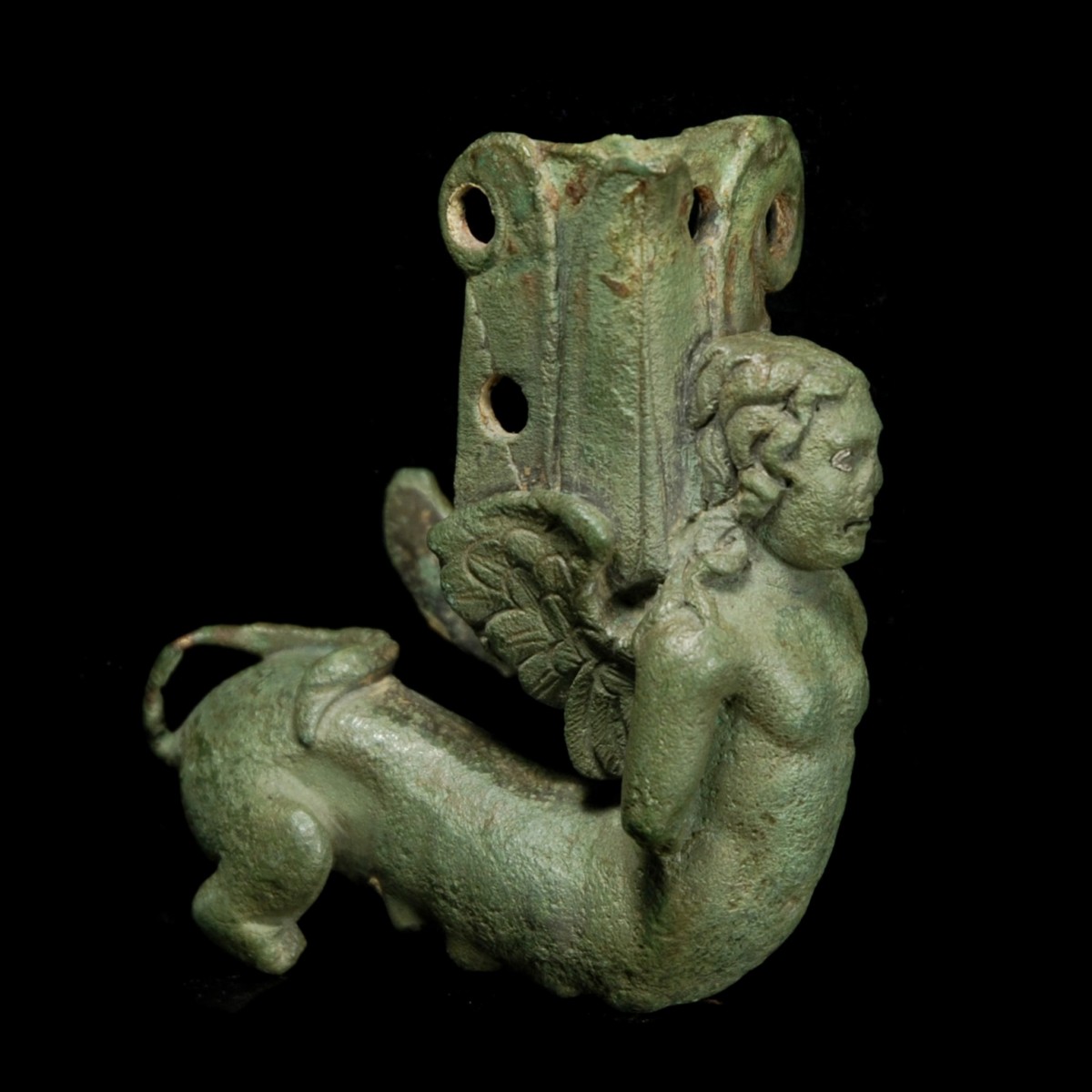
|
|
|
|
|
|
Roman Empire – 2nd century A.D.
|
Solid cast bronze statuette in form of a sphinx, which probably served as a furniture foot. The raised figure with a female head and upper body, the muscular lower body of a lion with a long, fluffy tail and drawn-up hind legs. The hair of the sphinx is parted in the middle and wavy falling down to the shoulders. The eyes inlaid in silver. The wings are worked out in great detail and spread out to the rear. The figure has a four-way perforated fitting on the back, which was fixed to a piece of furniture as a right corner piece.
|
Provenance: Private collection Lyon, France.
Dimensions: 8 cm x 7.5 cm
Price: 2 400 Euro
|
|
|
|
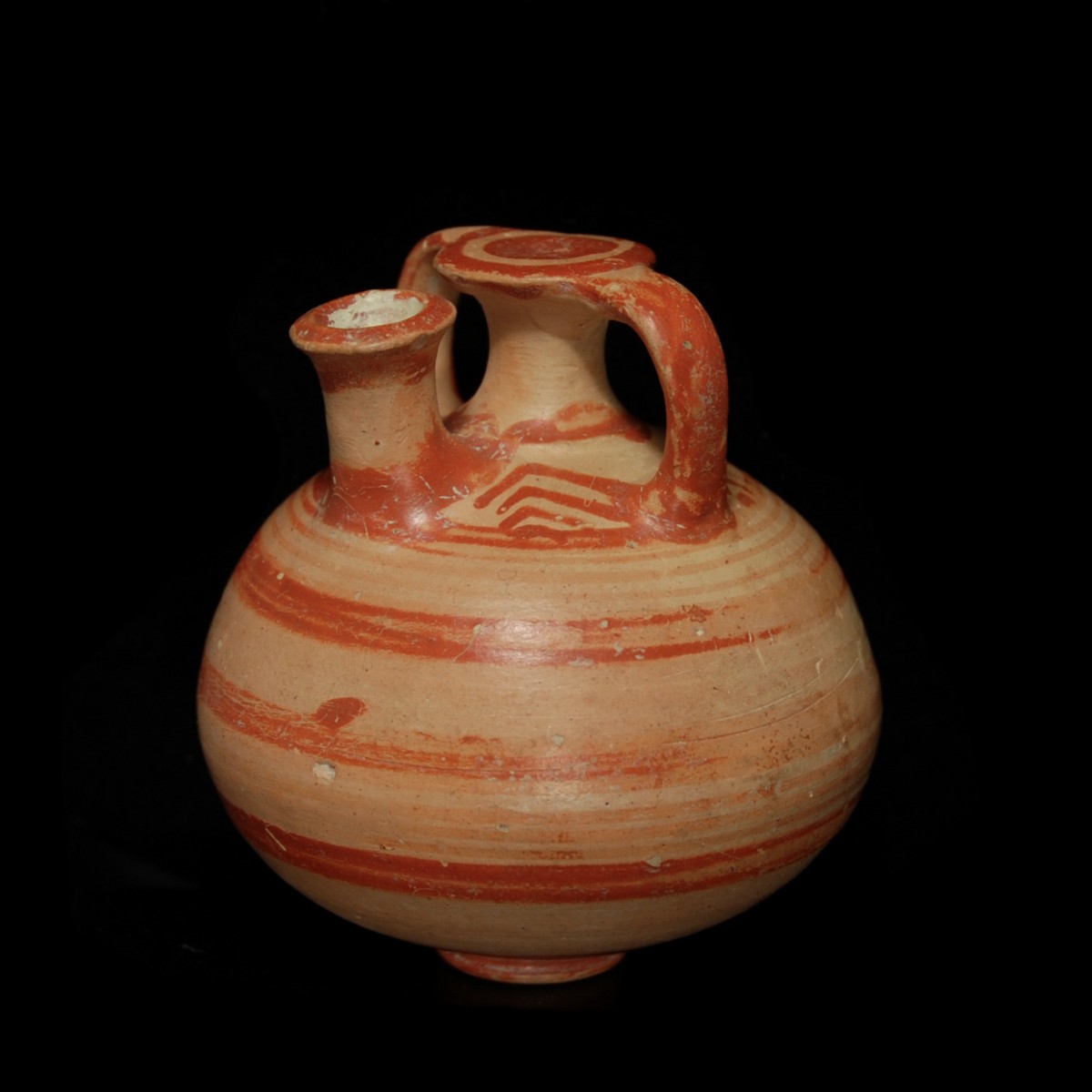
|
|
|
Beautifully preserved Mycenaean stirrup jar with reddish brown painting. On the bar head a large, fully painted circle which is framed by a circle on the edge. On the shoulder fan decoration. On the corpus three thick encircling bands, between them finely drawn encircling lines. The ring foot slightly offset. Stirrup jars were first produced around 1500 B.C. in Crete. The form was taken over and adapted by the Mycenaeans and was one of their most common export goods. The vessels were manufactured to hold precious liquids, such as aromatic olive oil or perfume.
|
Provenance: Rhenish private collection, acquired in December 1982. Thence collection G. E., Vienna, Austria. With a collection note.
Dimensions: 9.5 cm high
Price: 1 600 Euro
|
|
|
|
|
|
|
|
|
Egypt – Middle Kingdom to Late Period, 2133-332 B.C.
|
Newly threaded necklace with different colored faience beads and eight rare Horus eye amulets made of stone. The amulets made of carnelian, rock crystal, lapis lazuli, green slate and granite. The Horus eye is the left eye ("moon eye") of Horus, the god of light, healed and restored by the Egyptian god Thoth. It is also known as the udjat eye (udjat = intact, complete, whole, healthy). In keeping with its importance, udjat amulets had an apotropaic function and were intended to protect against diseases. Newly threaded on a thin wire, with clasp and ready to wear.
|
Provenance: Private collection Horatio and Patsy Melas, Alexandria, Egypt. Acquired prior to 1967. Thence by inheritance in Switzerland and in London.
Dimensions: 51 cm long
Price: 2 600 Euro
|
|
|
|
|
|
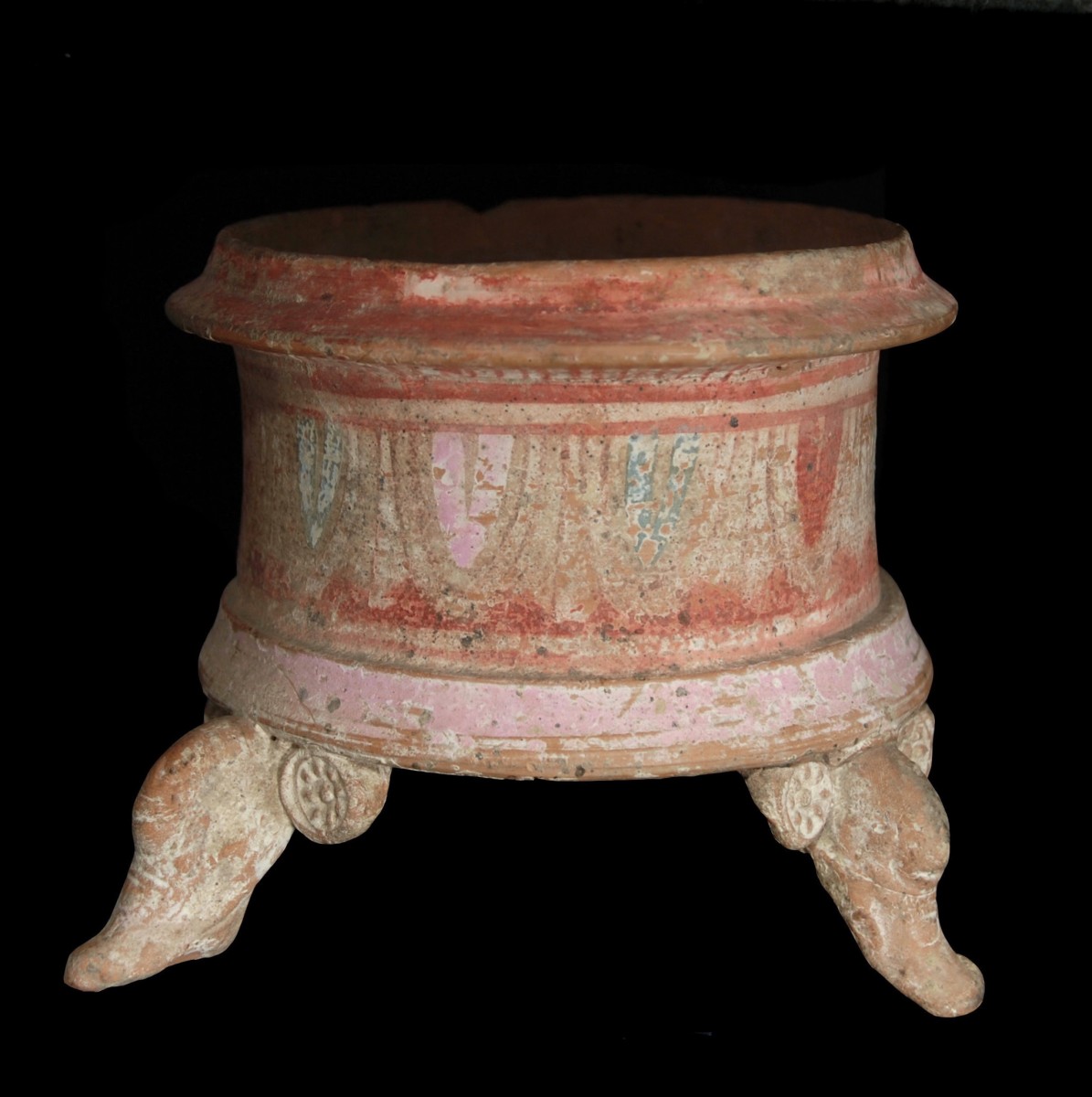
|
|
Greece/Canosa – 3rd century B.C.
|
Large terracotta pyxis from Canosa standing on three separately worked out feet in the form of swans' heads. On the sides of the heads also applied rosettes. The pyxis itself with abundantly preserved, polychrome painting. The rim in pink, on the corpus encircling tongue decoration in red, blue and pink. The rim protruding. The lid missing.
|
Provenance: Private collection Paris, France, acquired on 16 December 1984 from gallery Uraeus in Paris. With original certificate of 1984.
Dimensions: 14.5 cm high
Price: 1 600 Euro
|
|
|
|
Five Coptic Textiles from a German Collection:
|
|
|
|
|
|
Egypt – 5th-7th century A.D.
|
Almost square linen and wool fragment depicting in two registers in total four animals running to the right. In the upper part are possibly dogs, in the lower part possibly lions. Framed.
|
Provenance: German private collection, acquired prior to 1970.
Dimensions: 12 cm x 13.5 cm; 32 cm x 32 cm (dimensions of the frame)
Price: 480 Euro
|
|
|
|
|
|
|
|
|
Egypt – 5th-7th century A.D.
|
Almost square textile fragment of ocher and dark brown wool depicting five round medallions. Top left and bottom right a rider with a raised arm. At the top right and bottom left birds and trees. In the centre medallion winged creatures swirling around a bearded hybrid (centaur?). Between the medallions dancers and floral decoration. Framed behind glass.
|
Provenance: German private collection, acquired prior to 1970.
Dimensions: 20 cm x 17 cm; 32 cm x 35 cm (dimensions of the frame)
Price: 680 Euro
|
|
|
|
|
|
|
|
|
Egypt – 5th-7th century A.D.
|
Two square textiles of almost the same size of black and light brown fabric. In the middle of each a centaur, which was also in use in the Christian symbolism for a long time. It stands for a split personality, for a rational and irrational creature like a human being. At the same time centaurs are considered as immortal. The figures are framed, in the corners abundant ornaments. Together framed behind glass.
|
Provenance: German private collection, acquired prior to 1970.
Dimensions: each 10 cm x 10 cm; 36 cm x 24 cm (dimensions of the frame)
Price: 680 Euro
|
|
|
|
|
|
|
|
|
Egypt – 5th-7th century A.D.
|
Large linen fragment of a tunic with a vertical bar with crosses in different colors, trees and a stylized face. Left a separately worked out piece of natural wool with a lion to the left, above a tree and a small cross on the right part. Framed behind glass.
|
Provenance: German private collection, acquired prior to 1970.
Dimensions: 47 cm x 22 cm
Price: 980 Euro
|
|
|
|
|
|
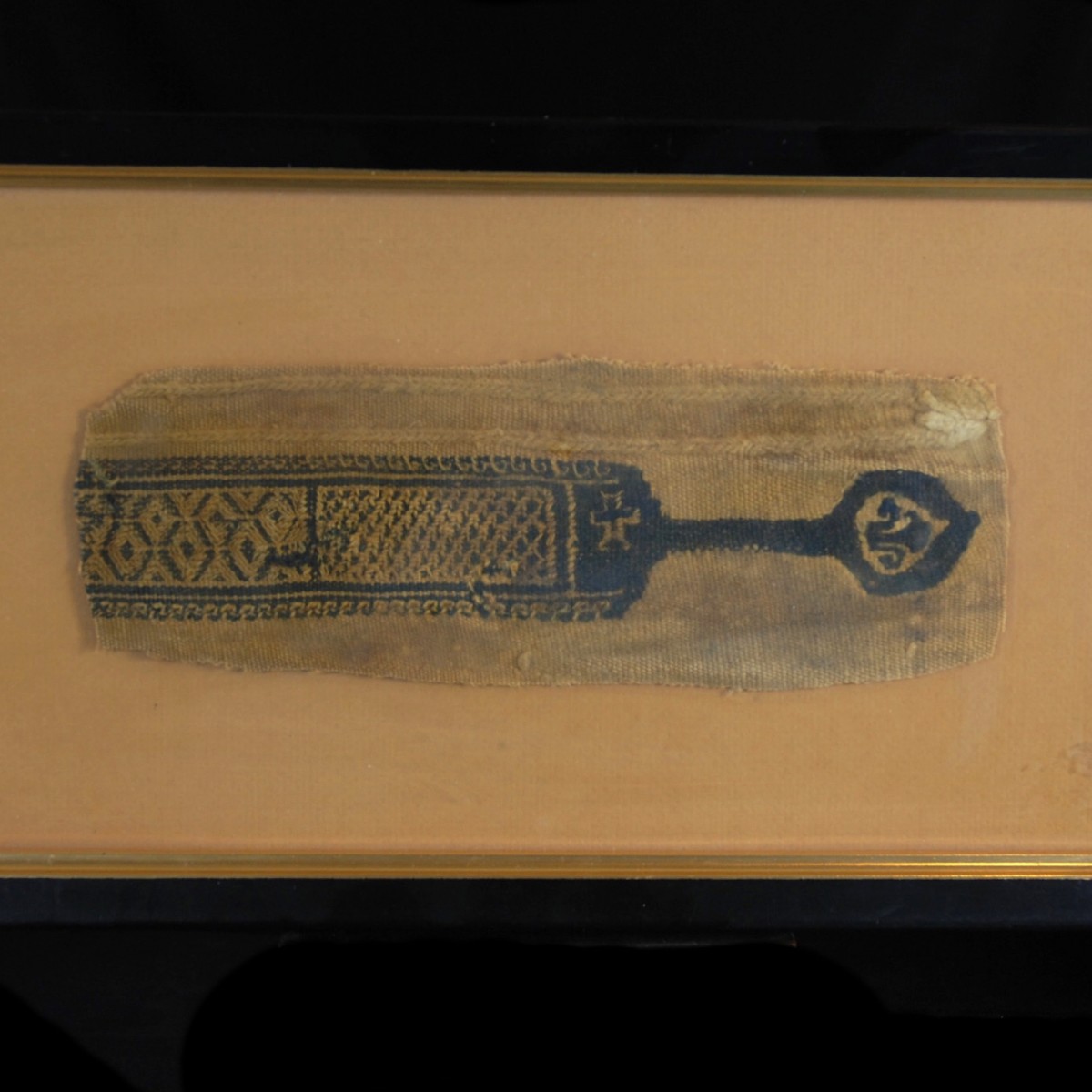
|
|
Egypt – 5th-7th century A.D.
|
Clavus of a Coptic tunic made of linen and wool. The ribbon with a wavy edge is decorated on the inside with geometric decor and dot motifs. This is followed by a cross on a dark background. On the end of the clavus the typical leaf-shaped medallion, the so-called sigillum. Framed.
|
Provenance: Collection Helena and Ladislas Segy, New York, acquired between 1950 and 1980.
Dimensions: 6.9 cm x 19.3 cm; 17.3 cm x 31.1 cm (dimensions of the frame)
Price: 420 Euro
|
|
|
|
|
|
Prosit Neujahr! Oder wie die Römer sagen würden: "Annum novum faustum felicem!"
|
|
Die gute Nachricht gleich vorweg: Obwohl unsere Galerien in Wien noch bis 17. Jänner 2021 geschlossen bleiben müssen, sind Abholungen jederzeit möglich. Wir freuen uns auch, dass wir für alle Objekte in diesem Newsletter (und die meisten auf unserer Website) einen kostenlosen Versand in alle Welt anbieten können. Die Pandemie kann uns zwar räumlich trennen, die Freude an Kunst der Antike kann sie uns jedoch nicht nehmen.
|
SAVE THE DATE. Und für 2021 sind wir nicht nur optimistisch, wir haben auch einiges vor: Schon am 27. Februar starten wir mit unserer Teilnahme an der WIKAM in ein intensives Messejahr in Wien und Salzburg. In unserem Showroom in Wien planen wir heuer gleich vier Ausstellungen, die erste unmittelbar nach der WIKAM. Und es ist uns gelungen, herausragende antike Sammlungen und Objekte zu erwerben, mit denen wir in diesem Jahr für einige Überraschungen sorgen werden. Einen ersten Vorgeschmack liefert dieser Newsletter mit dem chalkidischen Helm und dem samnitischen Dreiplattenpanzer aus der weltberühmten Sammlung Guttmann. Freuen Sie sich auf ein Jahr voller wunderbarer Momente, auf ein Jahr des Wiedersehens und ein Jahr, in das wir ganz besonders optimistisch starten!
|
|
Unser Highlight des Monats:
|
|
Griechenland – 5.-4. Jahrhundert v. Chr.
|
Seltener, chalkidischer Bronze-Helm mit deutlich abgesetzter, länglicher Kalotte, steilem Scheitelgrat und profiliertem Stirngiebel mit großem Gesichtsausschnitt. Auf der Stirn und im Nacken je eine Öse zur Befestigung des Helmbuschs. Spitze, festehende Wangenschirme, vor den großen Ohrenausschnitten je ein Kinnriemenloch. Der Nackenschutz ist kurz nach außen gebogen, der Helmrand umlaufend verdickt. Hinten im Nacken eine antike Reparatur. Innen ein altes Etikett der berühmten Sammlung Axel Guttmann mit der Aufschrift AG 194. Publiziert in: H. Born, Restaurierung antiker Bronzewaffen – Sammlung Axel Guttmann, Bd. 2, Mainz 1993, Beispiel II. Gesockelt.
|
Provenienz: Privatsammlung Axel Guttmann mit der Inventarnummer AG 194, erworben 1988 in Freiburg. Mit einer Fotografie, die den Helm in der Sammlung Guttmann zeigt. Danach Hermann Historica Auktion vom 7. Oktober 2009, Los 176 (dort mit nicht zugehörigem Helmbuschhalter verkauft). Zuletzt im englischen Kunsthandel. Mit französischem Antikenpass.
Höhe: 25 cm
Preis: 32.000 Euro
|
|
|
|
Ausgewählte Kunstwerke des Monats:
|
|
Ägypten – Spätzeit, 26. Dynastie, 664-525 v. Chr.
|
Überaus fein gearbeitete grüne und schwarze Fayence-Statuette der ägyptischen Göttin Taweret, die auch unter der griechischen Bezeichnung Thoëris bekannt ist. Taweret, die Schutzgöttin schwangerer Frauen, tritt im Körper eines trächtigen Nilpfers auf, hat menschliche Brüste sowie Kopf und Maul eines Nilpferds. Die Arme sind menschlich, die Pfoten bzw. Tatzen die eines Löwen. Vor dem Bauch hält sie in ihren Tatzen die Sa-Schleife, eine altägyptische Hieroglyphe, die für Schutz steht. Taweret trägt eine schwarze dreiteilige Perücke, deren vorderen Lappen bis zu den hängenden Brüsten reichen. Der Zapfen am Kopf hielt einst eine metallene Sonnenscheibe. Hinten ein schraffierter Rückenpfeiler, der für den stilisierten Schwanz des Krokodils steht. Die hohe Qualität dieser Statuette spricht dafür, dass sie für den Tempel hergestellt wurde, möglicherweise für das ägyptische „Geburtshaus“, wo Taweret mit Isis gleichgesetzt wurde. Auf altem, trapezförmigem Holzsockel.
|
Provenienz: Alte französische Privatsammlung erworben in den 1960er Jahren. Danach in der spanischen Privatsammlung O. P., Barcelona. Mit spanischem Antikenpass.
Höhe: 10 cm
Preis: 12.000 Euro
|
|
|
|
Annähernd identische Brust- und Rückenplatte eines sogenannten „Dreiplattenpanzers“ mit drei nach außen gewölbten Scheiben. Der obere Abschluss der Brustplatte mit nachmodellierten Schlüsselbeinen. Die beiden oberen Scheiben jeweils spitz zulaufend in Form von Brustmuskeln ausgebildet. Rundum in regelmäßigem Abstand gebohrte Futterlöcher, an den Seiten mittig je eine aufgenietete Lasche (eine fehlt) zur Befestigung der Seiten- und Schulterverbindungen. Auf der Rückseite jeweils ein altes Etikett der berühmten Sammlung Axel Guttmann mit der Aufschrift AG 433. Publiziert in: H. Born, Restaurierung antiker Bronzewaffen - Sammlung Axel Guttmann, Bd. 2 (Mainz 1993), Abb. 34, 35. Gesockelt.
|
Provenienz: Privatsammlung Axel Guttmann mit der Sammlungsnummer AG 433, erworben 1990 in Krefeld. Danach Hermann Historica Auktion vom 11. April 2008, Los 348. Zuletzt im englischen Kunsthandel.
Dimensionen: Höhe 30 cm (Brustpanzer), 28 cm (Rückenpanzer)
Preis: 12.000 Euro
|
|
|
|
|
Römisches Reich – Ende 2. Bis Anfang 3. Jahrhundert n. Chr.
|
Großes fein gearbeites Marmorrelief einer Grabplatte mit vierzeiliger Inschrift und zwei Eroten an den Außenseiten. Die Inschrift lautet: "Q. Lollius Lollianus vixit annis VII Menses V Dies V" (Übersetzung: "Q. Lollius Lollianus lebte sieben Jahre, fünf Monate und fünf Tage"). Die fein gearbeiteten Eroten mit gelockten Haaren und Umhang stehen in Nischen. Der linke hält eine Ente in der rechten Hand und stützt sich auf einen Speer in der linken. Er steht für den Winter. Sein Blick ist nach rechts zu seinem Gegenstück, dem Herbst gerichtet. Der Herbst-Cupido hält den Hasen in der linken Hand und stützt sich auf einen Speer in der rechten. Auf der fehlenden Unterseite waren wohl die beiden anderen Jahreszeiten abgebildet. Ein bewegendes Fragment von wunderbarer Qualtität. Gesockelt.
|
Provenienz: Aus alter amerikanischer Sammlung, versteigert bei Hindman Auctions im Oktober 2017. Danach im englischen Kunsthandel.
Dimensionen: 42,5 cm x 60 cm
Preis: 28.000 Euro
|
|
|
|
|
Ägypten – Spätzeit, 664-332 v. Chr.
|
Vollbronze-Statuette der schreitenden Sachmet mit dem linken Bein vorangestellt. Die löwenköpfige Göttin trägt eine dreiteilige Perücke mit fein gezogenen Strähnen, den Halskragen und ein enganliegendes Kleid, das bis zu den Knöcheln reicht. Sie hat beide Arme seitlich an den Körper gelegt. Am Kopf trägt sie eine große Sonnenscheibe mit Uräus. An den Füßen sind noch die Zapfen zur Befestigung in der separat gearbeiteten Basis erhalten. Sachmet, deren Name übersetzt „die Mächtige“ bedeutet, war die Göttin des Krieges aber auch des Schutzes vor Krankheiten und der Heilung. Gesockelt.
|
Provenienz: Privatsammlung Dr. Yves Goalard, Frankreich, erworben in den 1970er Jahren. Zuletzt in einem belgischen Auktionshaus.
Höhe: 20,5 cm (mit Zapfen)
Preis: 12.000 Euro
|
|
|
|
|
Ägypten – Mittleres Reich, 2040-1648 v. Chr.
|
Großes, mit der Hand geformtes Terrakotta-Nilpferd auf seiner Original-Plinthe. Das Tier mit abgerundetem Rücken, kurzen Beinen, Stummelschwanz und einem massiven, leicht gesenkten Kopf. Die Ohren, Augen und Nüstern kugelig und groß. Nilpferde wurden im Mittleren Reich häufig mit ins Grab gegeben, da das kräftige Tier als Zeichen für die Regeneration im Jenseits galt. Darüber hinaus sollte das furchteinflössende Tier, vor dem die Lebenden Angst hatten, auch Grabräubern Furcht einflößen. Mit Resten weißer Bemalung.
|
Provenienz: Sammlung des Kunsthändlers Elias David (1891-1969). Zuletzt in einer französischen Privatsammlung. Mit französischem Antikenpass.
Länge: 13,5 cm
Preis: 8.000 Euro
|
|
|
|
|
Sumer – 1. Hälfte 2. Jahrtausend v. Chr.
|
Beinahe kreisrunde Terrakotta-Plakette aus hellem Ton, die den dämonischen Kopf des Humbaba zeigt. Der Wächter des Zedernwaldes wurde von Gilgamesch und seinem treuen Freund Enkidu geköpft, weil diese im Wald der Göttin Inanna Zedern fällen wollten. Humbaba hatte als Dämon übernatürliche Fähigkeiten, er war im Besitz der Ängste und vermochte seine Feinde schon auf große Entfernung zu erkennen. Plaketten wie diese wurden daher verwendet, um das Böse fernzuhalten, aber auch um seinem Besitzer Glück zu bringen. Humbaba hat eine breite Nase, wache zwischen kräftigen Lidrändern sitzende Augen und tiefe Falten unter den Augen. Parallele Haarsträhnen fallen ihm in die Stirn. Der Mund ist zur breiten Fratze geöffnet und lässt die Zahnreihen erkennen. Typisch für die Darstellungen des Humbaba aus Mesopotamien ist der lange Schnauzbart, dessen Strähnen den Mund einrahmen und bis zum Kinn reichen. Die Bartenden sind eingerollt. Gesockelt.
|
Provenienz: Aus dem Nachlass Daryl P. Gruber-Kulok, New York und Connecticut. Zuletzt bei Art for Eternity, New York.
Dimensionen: 7 cm x 6,2 cm
Preis: 3.200 Euro
|
|
|
|
Großes Alabaster-Fragment einer sumerischen Beterstatue. Erhalten ist die Kaunakes, der mesopotamische Zottenrock aus dem 3. Jahrtausend v. Chr, der zu rituellen Zwecken getragen wurde. Die Kleidungsstücke bestanden aus einem Wollgewebe, das einem Schaffell nachempfunden wurde, indem Wollzotten stufig übereinander gesetzt eingewebt wurden oder beim Weben Schlaufen aus dem Schussfaden gezogen wurden, so dass ein Florgewebe entstand. Die Kaunakes dieser Beterstatue ist besonders fein gearbeitet. Der kegelige Rock ist umlaufend durch sechs, sich nach unten vergrößernde Reihen von Zotten gegliedert. Jede einzelne Zotte ist durch drei vertikale, tiefe Einkerbungen verziert. Der Oberkörper ist am Ansatz gebrochen. Die geglättete Unterseite des Rocks sowie die Beinstümpfe sind erhalten. Vergleiche zu den sumerischen Beterstatuen mit Kaunakes Pierre Amiet „Die Kunst des Alten Orient“, Abb. 288-293, München 1977. Gesockelt.
|
Provenienz: Deutsche Sammlung Ertel 1970er Jahre. Danach im Antikenkabinett Bernd Gackstätter mit der Listennummer 3215. Am 26. Oktober 2000 verkauft an die Privatsammlung Peter Hollander (1931-2014), Amsterdam. Seitdem in Familienbesitz. Mit Originalrechnung und Originalzertifikat des Antikenkabinetts.
Höhe: 14 cm
Preis: 8.000 Euro
|
|
|
|
|
Römisches Reich – 1. Drittel 2. Jahrtausend v. Chr.
|
Massiv gegossene Bronze-Statuette in Form einer Sphinx, die wohl als Möbelfuß diente. Die aufgerichtete Figur mit weiblichem Kopf und Oberkörper, der muskulöse Unterkörper eines Löwen mit langem, am Ende bauschigem Schweif und angezogenen Hinterläufen. Das Haar der Sphinx in der Mitte gescheitelt und wellig bis auf die Schultern herabfallend. Die Augen in Silber eingelegt. Die Flügel sind detailreich ausgearbeitet und nach hinten ausgebreitet. Die Figur trägt am Rücken einen vierfach gelochten Beschlag, der als rechtes Eckstück an einem Möbel fixiert war.
|
Provenienz: Privatsammlung Lyon, Frankreich.
Dimensionen: 8 cm x 7.5 cm
Preis: 2.400 Euro
|
|
|
|
|
Griechenland – 1400-1200 v. Chr.
|
Wunderbar erhaltene mykenische Bügelkanne mit rötlich brauner Bemalung. Auf dem Bürgelkopf ein großer, vollflächig bemalter Kreis, der von einem Kreis am Rand gerahmt wird. Auf der Schulter Fächerdekoration. Am Korpus drei dicke umlaufende Bänder, dazwischen fein gezogene umlaufende Linien. Der Ringfuß leicht abgesetzt. Bügelhenkelkannen wurden erstmals um 1500 v. Chr. auf Kreta hergestellt. Die Form wurde von den Mykenern übernommen und adaptiert und war eine ihrer am weitesten verbreiteten Exportgüter. Die Gefäße wurden hergestellt, um wertvolle Flüssigkeiten wie aromatisches Olivenöl oder Parfüm aufzunehmen.
|
Provenienz: Rheinische Privatsammlung, erworben im Dezember 1982. Danach Sammlung Gerald Ebinger, Wien. Mit Sammlungsnotiz.
Höhe: 9,5 cm
Preis: 1.600 Euro
|
|
|
|
|
Ägypten – Mittleres Reich bis Spätzeit, 2133-332 v. Chr.
|
Neu gefädelte Halskette mit verschiedenfarbigen Fayenceperlen und acht seltenen Horusaugen-Amuletten aus Stein. Die Amulette aus Karneol, Bergkristall, Lapislazuli, grünem Schiefer und Granit. Das Horusauge ist das vom ägyptischen Gott Thot geheilte, wiederhergestellte linke Auge („Mondauge“) des Lichtgottes Horus. Es wird auch als Udjat-Auge bezeichnet (udjat = intakt, vollständig, heil, gesund). Entsprechend seiner Bedeutung hatten Udjat-Amulette apotropäische Funktion und sollten vor Krankheiten schützen. Neu auf dünnem Draht gefädelt, mit Verschluss und sofort tragbar.
|
Provenienz: Privatsammlung Horatio und Patsy Melas, Alexandria, Ägypten. Erworben vor 1967. Danach Erbbesitz in der Schweiz und in London.
Länge: 51 cm
Preis: 2.600 Euro
|
|
|
|
|
Griechenland/Canosa – 3. Jahrhundert v. Chr.
|
Große Terrakotta-Pyxis aus Canosa, die auf drei separat gearbeiteten Füßen in der Form von Schwanenköpfen steht. Seitlich der Köpfe jeweils ebenfalls applizierte Rosetten. Die Pyxis selbst mit reich erhaltener, polychromer Bemalung. Der Rand unten in Rosa, am Korpus umlaufend Zungendekor in Rot, Blau und Rosa. Der Rand auskragend. Deckel fehlt.
|
Provenienz: Privatsammlung Paris, erworben am 16. Dezember 1984 in der Galerie Uraeus in Paris. Mit Original-Zertifikat von 1984.
Höhe: 14,5 cm
Preis: 1.600 Euro
|
|
|
|
Fünf koptische Stoffe aus einer süddeutschen Sammlung:
|
|
Ägypten – 5.-7. Jahrhundert n. Chr.
|
Fast quadratisches Fagment aus Leinen und Wolle, das in zwei Registern insgesamt vier Tiere nach rechts laufend zeigt. Im oberen Teil sind wohl Hunde zu erkennen, im unteren wohl Löwen. Gerahmt.
|
Provenienz: Deutsche Privatsammlung, erworben vor 1970.
Dimensionen: 12 cm x 13,5 cm; Rahmen: 32 cm x 32 cm
Preis: 480 Euro
|
|
|
|
|
Ägypten – 5.-7. Jahrhundert n. Chr.
|
Annähernd quadratisches Textilfragment aus ockerfarbener und dunkelbrauner Wolle, das fünf runde Medaillons zeigt. Links oben und rechts unten je ein Reiter mit erhobenem Arm. Rechts oben und links unten Vögel und Bäume. Im mittleren Medaillon umschwirren geflügelte Wesen ein bärtiges Mischwesen (Kentaur?). Zwischen den Medaillons Tänzerinnen und florales Dekor. Hinter Glas gerahmt.
|
Provenienz: Deutsche Privatsammlung, erworben vor 1970.
Dimensionen: 20 cm x 17 cm; Rahmen 32 cm x 35 cm
Preis: 680 Euro
|
|
|
|
|
Ägypten – 5.-7. Jahrhundert n. Chr.
|
Zwei annähernd gleich große, quadratische Textilien aus schwarzem und hellbraunem Stoff. In der Mitte jeweils ein Kentaur, der auch in der christlichen Symbolik noch lange in Verwendung war. Er steht für das gespaltene Wesen, für ein rationales und irrationales Wesen, wie es der Mensch ist. Gleichzeitig gelten Kentauroi als unsterblich. Die Figuren sind umrahmt, in den Ecken reiche Ornamentik. Hinter Glas gerahmt.
|
Provenienz: Deutsche Privatsammlung, erworben vor 1970.
Dimensionen: je 10 cm x 10 cm; Rahmen 36 cm x 24 cm
Preis: 680 Euro
|
|
|
|
|
Ägypten – 5.-7. Jahrhundert n. Chr.
|
Großes Leinen-Fragment einer Tunika mit einer senkrechten Leiste, auf der Kreuze in verschiedenen Farben, Bäume und ein stilisiertes Gesicht zu erkennen sind. Links ein separat gearbeitetes Stück aus Naturwolle mit einem Löwen nach links, darüber ein Baum und einem kleinen Kreuz im rechten Teil. Hinter Glas gerahmt.
|
Provenienz: Deutsche Privatsammlung, erworben vor 1970.
Dimensionen: 47 cm x 22 cm
Preis: 980 Euro
|
|
|
|
|
Ägypten – 5.-7. Jahrhundert n. Chr.
|
Clavus einer koptischen Tunika aus Leinen und Wolle. Das Band mit wellenförmigen Rand ist innen mit geometrischem Dekor und Punktmotiven verziert. Daran anschließend ein Kreuz auf dunklem Grund. Am Ende des Clavus das typische, blattförmige Medaillon, das sogenannte Sigillum. Gerahmt.
|
Provenienz: Sammlung Helena und Ladislas Segy, New York, erworben zwischen 1950 und 1980.
Dimensionen: Dimensionen: 6,9 cm x 19,3 cm; Dimensionen Rahmen: 17,3 cm x 31,1 cm
Preis: 420 Euro
|
|
|
|
|
|
|
|
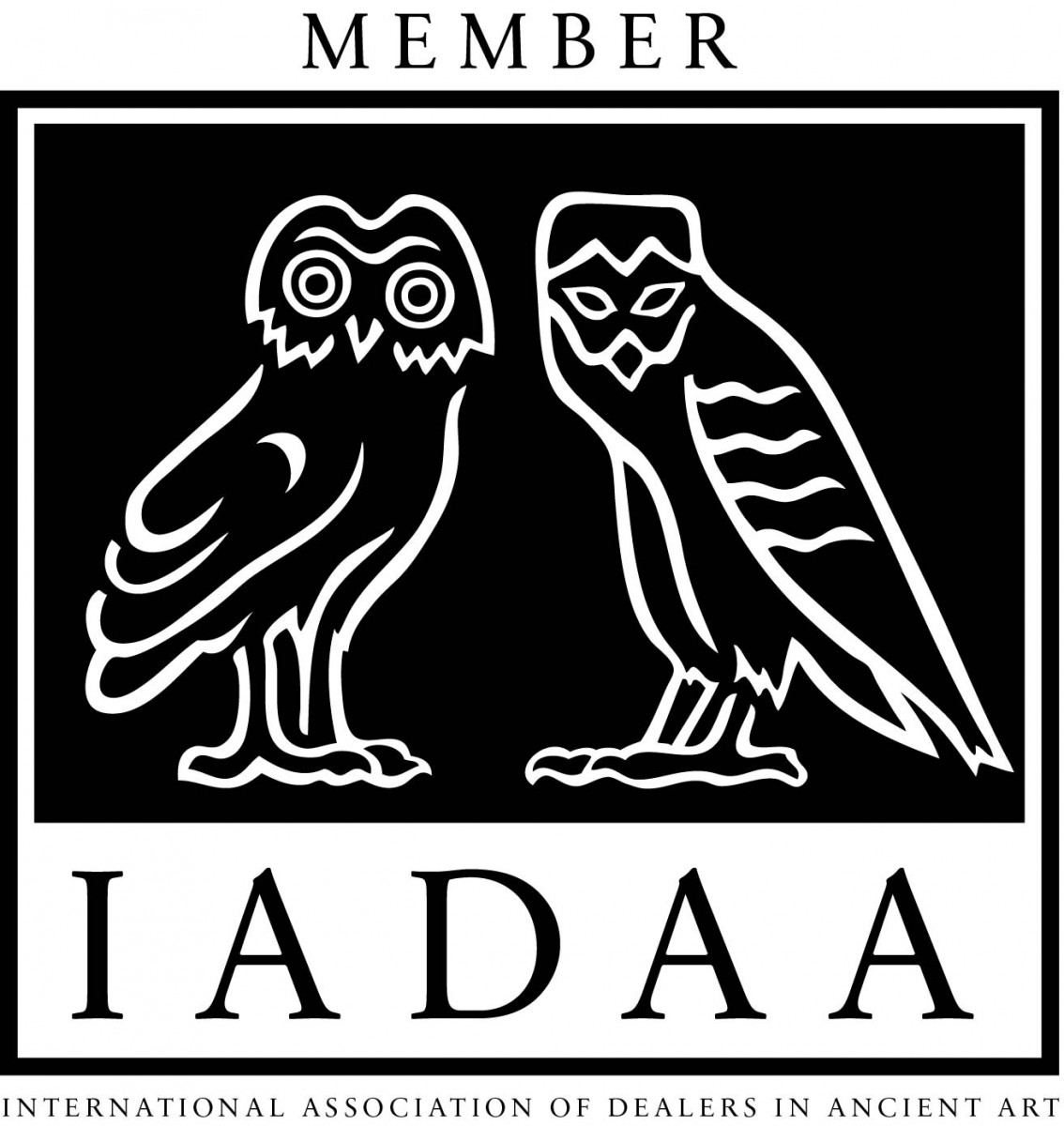
|
|
|
|